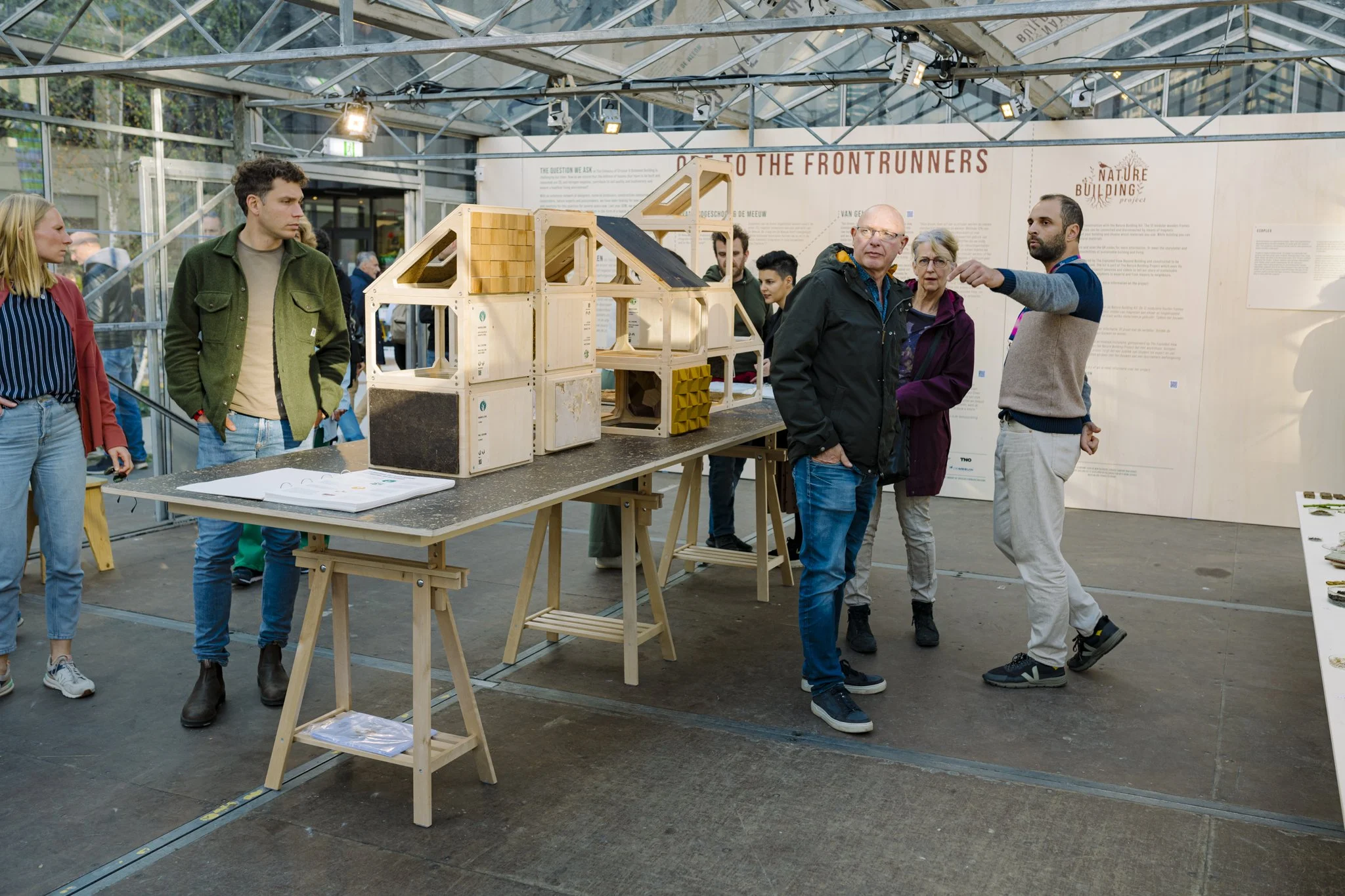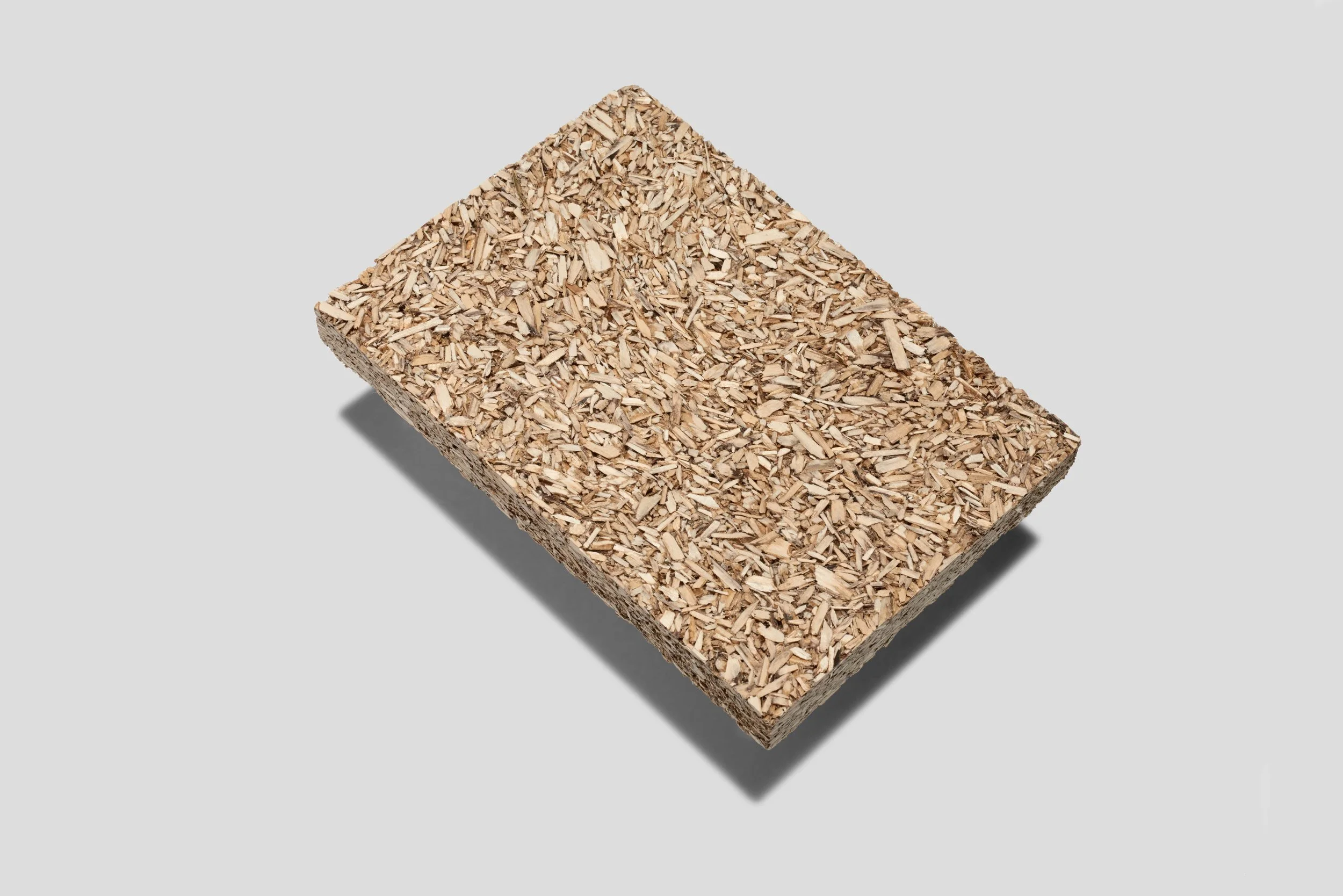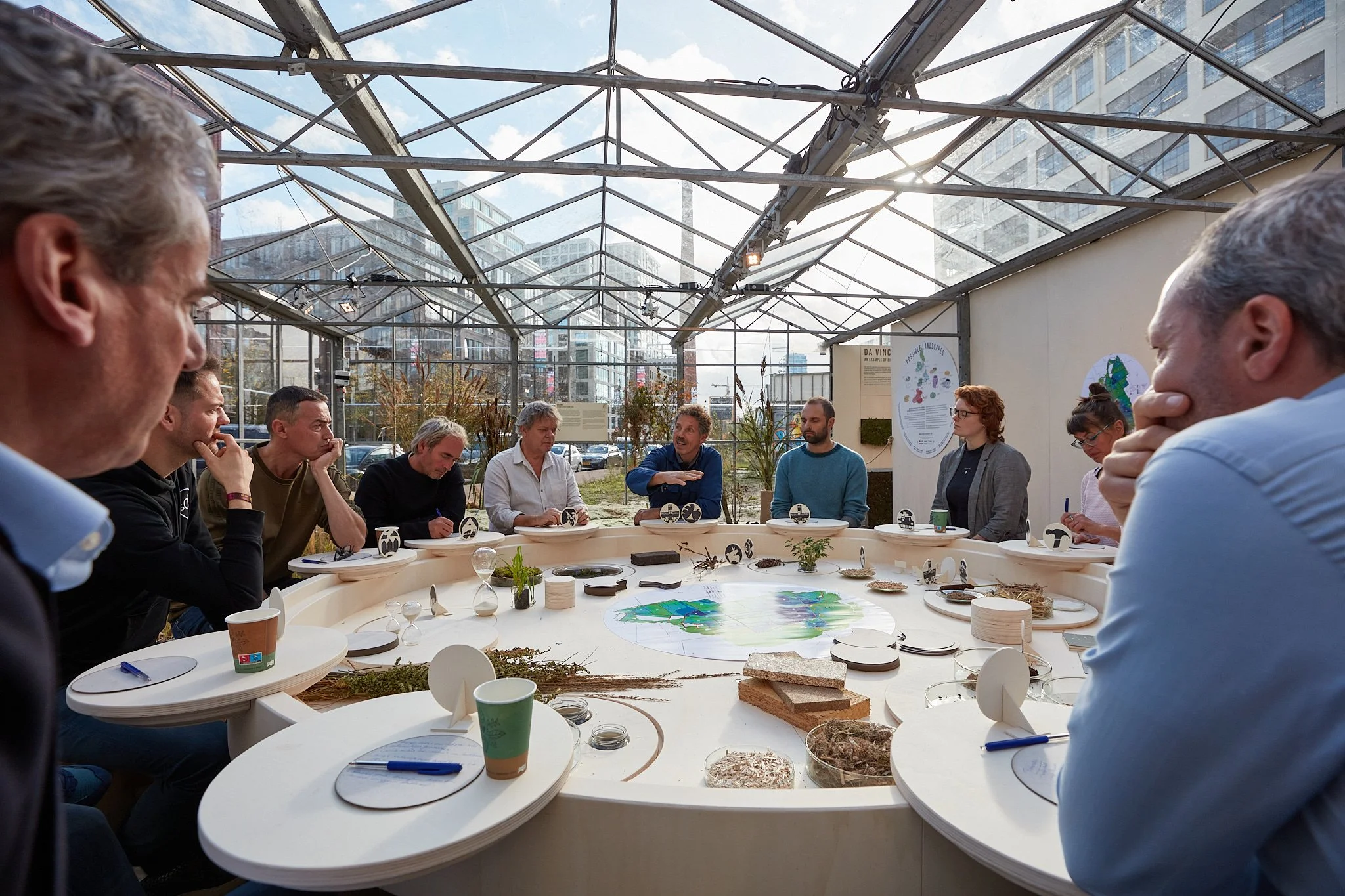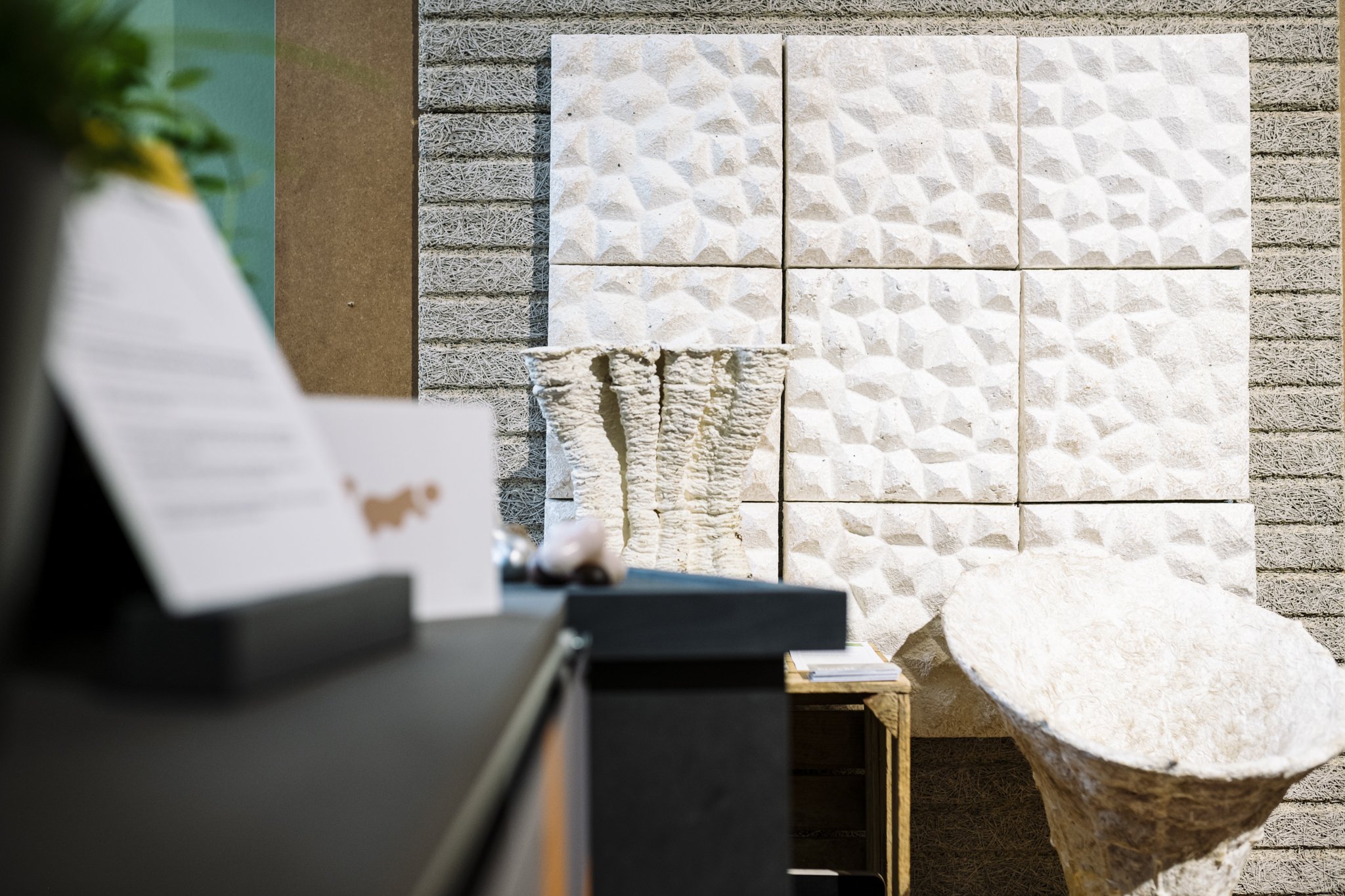Circular and Biobased Building
The Dutch Design Foundation’s World Design Embassies are a set of organisations that deploy the power of design to create fresh perspectives and new ways of working that foster positive societal change. Each focuses on a specific topic including Society, Water, Health and Food, and their collaborative research approach is matched by a shared impetus for action. Now active for its 5th year, the Embassy of Circular and Biobased Building returned to Dutch Design Week with a new vision for how we might build our homes differently under the banner, Ode to the Daredevils. Their research and the resulting set of solutions on display during the event started with a specific line of inquiry:
“How do we ensure that the millions of homes that will be built and renovated in the coming years are CO2 and nitrogen-negative? How can these homes contribute to soil quality, biodiversity, and a healthier living environment? These questions are central to the Embassy of Circular & Biobased Building.”
This years display followed on from last years The Exploded View Beyond Building, which in true Emabssy style, the practitioners involved used a springboard for new experimentation and material developments. Whilst some of the ideas presented were at the more conceptual end of the spectrum, many took the form of solid and viable building options; although all had the primary focus of exploring how our living environments can become more sustainable and circular. The ability to measure the positive impact of such projects is made all the more easier and in-depth with the support of another Dutch organisation with progress in sustainability at its heart. TNO has been in operation since 1932 and their mission is clear; to connect people and knowledge to create innovations. The TNO Fieldlab Emissionless Building project has carried out comprehensive studies of 9 innovative materials and building structures first show within The Exploded View Beyond Building. Their aim was to ascertain how well they can contribute to CO2 and nitrogen reduction, as well as how they might be further improved; not least in considering what challenges, such as scaling up, may face them. In pulling this information together the organisation has created a 6 part agenda that seeks to challenge the industry, government and consumers alike to think differently.
Of the 9 specific materials TNO have worked with that were on display during Ode to the Daredevils, we have already discussed Mogu and Studio Klarenbeek & Droos in our article focused around materials that are grown. Mycelium, algae and seaweed are the organic substances utilised in those projects, and the latter is also explored by Dutch company BlueBlocks, who can safely call themselves pioneers of the “blue economy.” The term, coined by Gunter Pauli, refers to those who use regenerative processes that are inspired by nature and go beyond the “lesser evil” model of the “green economy,” which includes circular methods, which Pauli argues don’t go far enough in making a genuine positive impact.
BlueBlocks founder Marjanne Cuypers and her team are appropriately based in Rotterdam’s Blue City; a former subtropical swimming pool that now houses innovative sustainably-minded start-ups and design practices. From there the team have experimented with seaweed in the development of material solutions for seating, bags, light shades and SeaWood. As the name suggests, the latter offers an alternative to wood in the creation of sheet materials that share very similar properties to standard products such as MDF, only without any of the nasty chemicals. And of course, the raw materials themselves are entirely sustainable in that they are locally abundant and regenerative.
Cuypers and co. express the very compelling argument, “If we can create systems with waste, we can also design them without,” which is a mindset shared by Eindhoven-based designer Rik Makes, who is also a fellow proponent for more ecologically and human friendly sheet materials. He affixs “materials that add to the ecocyle,” to his mantra and this is apparent in development of his suitably named Compostboard material. Locally sourced natural waste from flora and fauna such as hemp chips, flowers and straw dust are combined with natural binders and can be formed into flat surfaces or moulded into 3-D forms, making it an adaptable interior solution.
Whilst distinct in its raw and natural appearance, the application of natural dyes allows for customisation and product developments have already included sculpted curved furniture as well as flat surfaces that include wall panels. Some of the hidden properties of the material include its ability to breathe; drawing in moisture and cooling in the summer. But perhaps the real beauty of the material, and with it, any products it may become, is that it naturally biodegrades. Once disposed of outside the natural substances locked into the surface begin to break down until, as its name suggests, it turns into an ecologically beneficial compost.
Hemp is the super material of choice for Belgian brand Exie, who create building solutions that you may never see but will certainly feel the benefit of in a built environment. Out of sight and out of mind is often the way when it comes to insulation, but without it our buildings become inhospitable. Whilst there are a number of material options available to create effective insulation, CaNaDry offers a definitively ecological solution; which is not always the case when it comes to this part of a build, or renovation project. Ustilising lime hemp, which is dried and processed close to where it is grown, reduces any environmental impact in the manufacturing process, and because it is a grown material it also locks in CO2. It perhaps goes without saying, but lime hemp is also a perfect substance for insulating buildings. This is because it acts as a natural temperature buffer, and once again, it also helps with moisture control, which whilst once more unseen, goes a long way in making healthier environments to live in. CaNaDry can be used in walls and ceilings with ease and, combined with a layer of crushed shells that collect rising damp, it can also be used to insulate floors.
Strotec’s prefab HSB system EcoCocon, goes one step further with its ecological ambitions in offering an all-empassing building solution. The biobased facade structures consist of timber frames that are filled with straw with a 1:9 ratio. Being made to order off-site means that these variably sized all-natural construction blocks are incredibly adaptable and massively reduce waste. But again, they also store huge amounts of CO2, whilst out performing buildings consisting of layers of individually manufactured, delivered and fitted materials.
Finding a complete approach to construction through the use of sustainable materials is the driving force behind a collaboration between Omlab and Lilian van Daal. They have focused upon existing waste streams, and what better waste to transform than entirely unavoidable yet renewable sewage? In diverting waste water and sewage they have created a new, and clean, 3-D printable substance.
The circular, bio and waste-based material, is known as Omatterial, and has already been used to print prefab building materials such as pipes, as well as furniture. And the team behind it are already exploring how this process can be upscaled further in order to produce waste-free building, made almost entirely from waste itself.
Scape Agency has turned its attention to one of the world’s worst material pollutants, by creating bioreceptive alternatives to standard concrete. The process involves integrating mosses within the construction material, transforming it into a CO2-absorbing surface once they grow. Not only does this make the material more green than grey in both a literal and metaphorical sense, but the other raw materials used to make the composite also come from more ecologically sound sources. This is a primary example of where TNO’s Field Lab has made an insightful difference, having suggested that sediment dredged from waterways be used to replace finite raw materials such as sand.
Once again, the Embassy has stepped up in supporting and showcasing materials and systems that are ecologically sound, and with it call for new and adapted rules for building regulations that firmly put regenerative, biobased and reduced waste and CO2 practices at the fore.
This article was originally published by Design Insider










